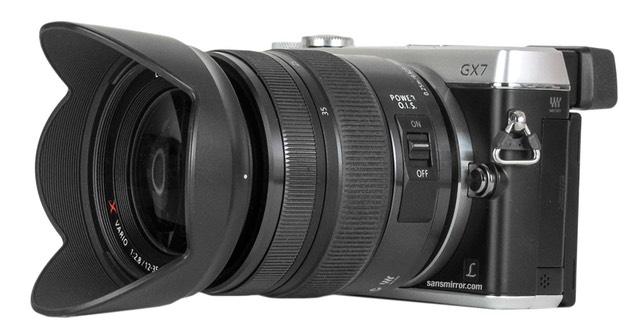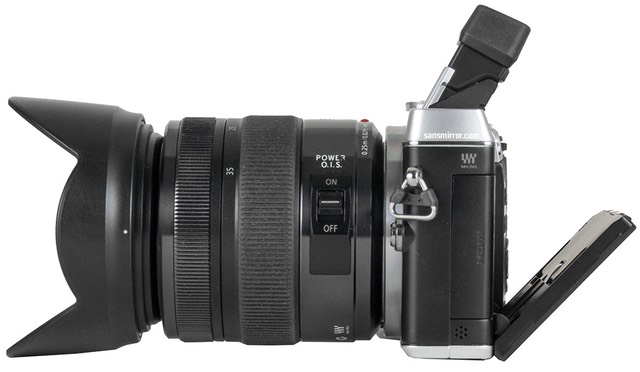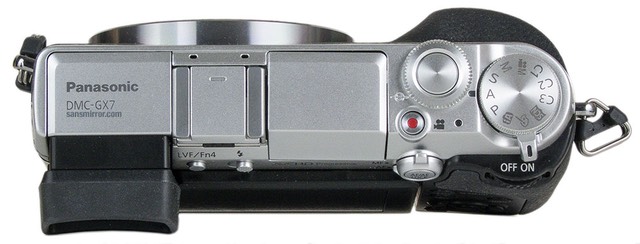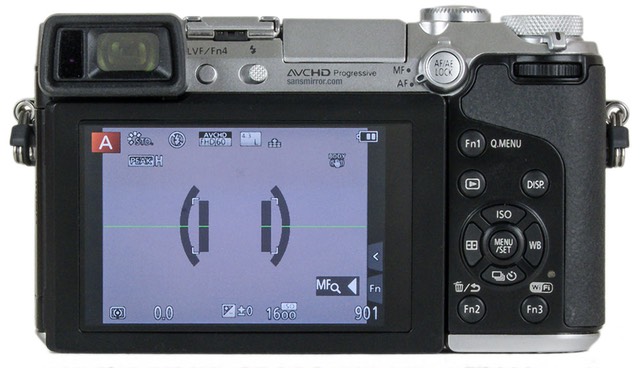
What is It?
The Lumix GX7 is the most recent in Panasonic's rangefinder-style, prosumer-type bodies. The road to the GX7 is a bit confusing, as it starts with the GF1. Then Panasonic changed the GF models into lower, more consumer oriented cameras and eventually returned to the prosumer client with the GX1. In order to get their numbering better aligned, Panasonic appears to have skipped the GX2 through GX6, so we now have the GX7 as the current entrant.
The GX7 is bigger in every dimension than the GX1, by the way, though it still remains a rather compact design. It's also bigger than a Sony NEX-6 and Olympus E-P5, but smaller than the Fujifilm X-E1/2. That said, I'm not sure the differences are enough to factor into anyone's buying decisions. Indeed, the Fujifilm and Sony have larger sensors, and thus tend to have larger equivalent lenses.
By rangefinder-style, I mean a basic rectangular shape with viewfinder, but no prism hump on top. These bodies tend to be defined by being smallish for their abilities. We have rangefinder-style bodies from other companies, most notably the Fujifilm X-E series and the Sony NEX-6 and NEX-7. All are reasonably compact, yet highly sophisticated cameras.
The GX7 is a bit deceptive at first glance. Someone went for a very simple looking design, and there doesn't seem to be the over-abundance of controls you see on some cameras these days. But as I wrote, there's some deception there. Most people don't see the two control dials at first, because one surrounds the shutter release and the other is a black dial set into a black area of the camera. The AF/MF switch surrounds the AF/AE lock button. In other words, the controls you want are probably all there, they're just very tightly integrated into the design.
Most folk want to know about the displays first, so let's look at them: the interesting aspect of the GX7 is the tilting 2.764 dot EVF at the far left on the back of the camera. In its normal position, everything looks as you'd expect. However you can tilt the EVF up about 90°, so that you look down into it from the top of the camera. Those that do low-level or macro will love this aspect of the viewfinder, but I've found that it also allows me to shoot upside down a bit above me, too. The EVF itself has a fairly fast refresh with plenty of dots, though it also has a fair amount of contrast to it (looks a bit more like a small video monitor than some EVFs I've used). As with most EVFs these days, there is an eye-detect system to turn it on and off automatically (which can be overridden). Panasonic claims the viewfinder covers the AdobeRGB color space, but I find that it's not color accurate.

You also have a 3" tilting touchscreen LCD on the back of the camera. You can touch to focus, touch to shoot, and touch to reach certain settings. I'll have more to say on that in the handling section.
The image sensor in the camera is a 16mp m4/3 sensor that generates 4592 x 3448 pixel images. It has a fast 120Hz refresh and supports 4.3 fps with continuous autofocus, up to 40 fps with an electronic shutter mode and no focus. Video is well enabled with 1080P/60/50/30/24 support, though Panasonic sells PAL and NTSC models separately, so what you get will vary with your country. As with most Panasonic cameras, the video is best done in AVCHD format, though Motion JPEG is also supported. ISO 125-25,600 is supported, with auto ISO limiting available as well. ISO can be set quickly via button plus dial, as can ISO limiting.
The shutter supports 60 second to 1/8000 second exposures, though it also has a bulb limit of 2 minutes, which some might find restricting. Flash sync is 1/250 for external flash units, and 1/320 for the internal flash.
It might surprise you to know that the GX7 has both a lens-centered hot shoe as well as a small pop-up flash. Generally the rangefinder-style cameras find that they have limited room up top of the camera, but Panasonic's moving and combining some of the controls gave them plenty of top plate space to put all three things side by side. The built-in flash isn't powerful (5m at ISO 100), but you can forceably move it to a tilt position with your finger.

Focus is still only contrast-detect on the GX7, which is a bit behind what the other players are doing these days, but it's a fast contrast detect. For single shot use it should be fine.
The camera isn't particularly big (4.8 x 2.8 x 2.2") or heavy (14.2 ounces, or 402g), but it's certainly substantively larger and heavier than some of the consumer m4/3 options available, including Panasonic's own GM1. You can get the body in all black or in panda (silver over black) styles, and while the price originally was US$1000 for the body only, these days you can find it for considerably less (US$800 as I write this). That's just low enough that the GX7 becomes one of those mirrorless cameras that might attract the DSLR user who wants to get smaller and lighter.
The tripod socket is centered with the lens.
The camera is made in Japan and it's build quality is what I would consider above average (magnesium alloy body), with very tight fittings, good materials use, and controls that are stiff but smooth.
How's it Handle?
I suspect that the GX7 is one of those cameras that will get varied responses in terms of handling and ergonomics. Part of that is due to the way Panasonic crammed so much into such a small space, coupled with all the customization options.
Let's start with some of the best aspects of the camera.
The GX7 has a fairly distinct front grip on it, covered with a rubberized substance. While the grip doesn't stick out in DSLR-like proportions, it does give you something to grab hold of. The material does get a little slippery when wet, but it's still far better than plain metal and the grip size is far better than no grip at all. Unlike some rangefinder-style cameras, you can one-hand the GX7 both while shooting or just while holding the camera while looking for something to shoot.
The cluster of controls up top (and rear-top) of the camera are all very nicely done, though very tightly grouped. The two dials are easily found while gripping the camera, though I suspect those with large hands and long fingers will find the positions to be a little too close together and confining. They work fine for me, but I don't have large hands.

I also like the choices Panasonic made for all these controls. The On/Off switch is a switch, and it's locating in a natural position, not randomly located as we're finding with some cameras these days. The switch is stiff, so it's unlikely you'll accidentally turn the camera on or off.
Both control dials are "notched" (move to specific positions, not freely rotating), which is my preference, and which works extremely well with the way Panasonic has implemented their interaction with other controls. For example, when setting ISO the rear dial cleanly moves from ISO value to ISO value at each notch point, while the top dial cleanly sets ISO Limit to On or Off as you rotate between notches. Some settings systems make it too easy to "overshoot" what you wanted to set. Panasonic has got this dead-on right: you'll likely dial exactly what you wanted because the dials have some resistance and they stop cleanly at each setting position.
The red Record Video button is indented and not in a position where you're likely to accidentally hit it, yet it's in a position that's easy enough to find. Again, a nice touch that a lot of other cameras get wrong. Meanwhile, we've got two focus settings combined in one dual control right where the right thumb is going to find them.
Things go a bit downhill from there, unfortunately.
For instance, that grip on the front? That positions my hand so that it blocks the AF Assist Lamp, a common problem on lots of cameras these days. I'm not a big fan of the AF Assist Lamps in the first place, but there are times when they're useful. But if to use them you have to change how you hold the camera, that's a bad choice. But then again, the bigger lenses all block the lamp, too (e.g. the Panasonic 12-35mm f/2.8, especially with the lens hood on). Features that are often compromised sometimes aren't worth having, in my view.
The FN1, FN2, and FN3 buttons are small black compact-camera style buttons arrayed around the Direction pad. They're tough to find by feel, which is a real shame, as having so many programmable buttons should be a benefit. In low light, the black buttons on black surface with thin lettering are tough to distinguish, too.
Other strangely fiddly aspects of the camera include getting to the connectors on the left side of the camera. You pretty much have to lift the tiltable LCD to get the door covering the connectors open. The battery/card compartment door is something that bugs me a bit, too. It's diagonally placed at the bottom of the grip on the camera. I'm so used to physically moving a battery door open latch with or against the long axis of the camera that I find that every time I go to open the door, I have to look at what I'm doing, as a 45° move isn't one that feels natural.
The menu system has both pluses and minuses to it. In order to make the touchscreen work, options are displayed in relatively big type. Unfortunately, that means only five to a page, so the shooting menu becomes 7 pages deep, the video menu is 4, the custom settings 8, the setup menu 6, and even the playback menu is 4 pages long. Yep, that's 29 menu pages to wade through. Some of those are going to be used by less than .1% of the purchasers of the camera, methinks. How many of you have Vierra TVs that you want to direct link to? [Actually, the Vierra Link will work with any HDMI/CEC standard TV, but instead of saying that in the menus, we get a marketing message instead.] As with many camera makers, the menus aren't optimized very well, either. Clock Set is the number one option on the 6 pages of SETUP, but Format is the last option. Which do you use more? ;~) The good news is that menus remember where you left them, so since Format is the thing I most often use on that menu, that's where the menu takes me when I invoke it. Still, grouping options into likely use would be helpful.

I mostly like the touchscreen aspects of the rear LCD. Working from a tripod doing landscape shooting, the touch-to-focus bit is nice to have. As with some earlier Panasonic models, the GX7 also moves the touch settings off the image display until you invoke them (they're pop-out tabs when not active; see the < and Fn at right of the display, above).
I can easily see the full EVF with glasses on, and folk with big noses will find the position of the EVF better than the standard centered DSLR viewfinder. I do find the EVF a little contrasty and a little grainy in very low light, but for most work it's fine and near state-of-the-art.
Overall, for being a relatively small camera, the GX7 manages to handle pretty darned well for the serious photographer. There are some things you need to adopt to, and the programmable buttons are hard to find, but for most work I found it a comfortable camera to use. You'll want to pay a lot of attention to setting it up for your work, though. Like the Olympus m4/3 cameras, there are a lot of configurable options, almost to the point of overwhelming. It pays to spend the time to figure out how to optimize the GX7 the way it best works for you. This took me about a week to get to the point where I felt I had dialed in everything the way I wanted it.
How's it Perform?
In a word: well. Like Olympus, Panasonic has been pushing virtually all aspects of performance upwards, and it shows on the GX7.
Focus: For single acquisition (single servo) type of focus, focus is very fast, perhaps faster than the entry DSLRs these days in some situations. Low light and low contrast tend to slow it down, but those conditions slow all cameras down. Continuous focus performance still leaves a lot to be desired, as on many fast and erratic motions the back-and-forth hunting of the contrast focus system tends to fall behind and never catch up. If the motion isn't too quick or erratic, continuous autofocus is usable, but lags what you'd get out of a good DSLR set properly. That said, both types of focus performance are better on the GX7 than they have been on virtually any previous Panasonic camera.
Battery: It's going to depend a bit on the lens you use, as from my testing it appears that some of the OIS lens are pulling just a bit more power from the camera. And as with all the EVF cameras, use of the EVF instead of the rear LCD tends to shorten battery life. Panasonic claims 350 shots on the CIPA testing. I didn't quite hit that number, though I've been above 300 for most sessions (when I'm testing, I tend to be tough on batteries, as I'm exploring the camera more than I would if I were just shooting).
Buffer and Write speed: JPEG shooters won't have a lot of problems with the camera in normal settings. With the mechanical shutter active, you can pretty much shoot until the card is full if you're using a fast UHS-I card (e.g. 95MBps). Turn on the electronic shutter and the camera has a limited buffer, just over 20 shots in JPEG. If you use the Super High electronic shutter setting, you get two seconds worth of 40 fps shooting (with no focus or exposure changes).
Raw shooters will find the camera a bit more limiting. Typically you'll get about 10 shots before the buffer fills, slightly less if you shoot Raw+JPEG. And on my camera, a full buffer was emptying in about 10 seconds while shooting raw.
Image Quality: Panasonic's JPEGs still aren't likely to be as attractive to most shooters as the Olympus JPEGs. But Olympus is putting more contrast and a bit more saturation into their JPEG images by default, so some of this is just the way the cameras are set up to shoot as they come out of the box. You can certainly goose up the contrast and saturation of the GX7 and get something closer to what Olympus has set to their default.
Still, there are two aspects to the Panasonic imaging ASIC's JPEG rendering that aren't quite up to the level of Olympus: detail rendering and noise handling. A lot of folk probably wouldn't notice the difference in either, but it certainly seems to be there for me I pixel peep: the Panasonic, even pushing the settings around to the best I can, seems to leave a very tiny bit of detail out that the Olympus doesn't. With raw files I'd say they're equal in capability, but not with JPEGs. Likewise, the noise reduction at high ISO values is doing more smudging of detail than Olympus cameras do in JPEGs, though it's a very well controlled smudging, without the blotchiness I've seem from some other rendering engines. Indeed, I'd even say the Olympus is "more blotchy" at very high ISO values, even though it retains a bit more detail and keeps color fidelity better.
It also seems clear to me that the Panasonic is still doing significant noise reduction at the -5 setting. I hate arbitrary numbers like that, and 5 sure seems big, big enough that maybe I shouldn't still be seeing NR? But I am.
Now, you may expect me to write that what Olympus does is better. I'm not sure it is. This is actually an argument I've been having with others on differences between Nikon and Canon JPEGs, too. Both Nikon and Panasonic seem to be going more for gentle, more neutral JPEGs, while Canon and Olympus put a little more oomph and sometimes a bit of shift into their default settings. The Canon and Olympus ASICs just seem more aggressive overall. Most people like that if they're not going to do any post processing. But sometimes that aggression makes post processing tougher. There's really no perfect answer here. (Well there is: we need camera companies to adopt the new 12-bit JPEG standard, including the no compression ability; then we'd have more flexibility in post processing when the cameras put a little too much of something into the image.)
The JPEGs the GX7 produces are the best I've seen out of Panasonic, and frankly, I like the light touch they put on the data. If I had to complain about anything, there's just a touch too much yellow in most of the default color rendering.
Which brings me to white balance. The one aspect I think Panasonic needs to improve more is their handling of white balance, especially when the camera is set to Auto. The GX7 isn't as bad as some of the original Panasonic m4/3 offerings, but I still find it wrong too much of the time. That's a shame. While I have almost 40 years worth of dealing with white balance now (I was an early user of digital video systems) and can see when things aren't right, most people using this camera probably don't and thus may end up with some "slightly off" images if they rely upon Auto WB. That said, the GX7 gets it right more often than some previous G's did.
But let's look at the basketball shot:

I've opted to show an underexposed JPEG at 100% (ISO 3200, as always). The reason for that is simple: this is really quite good results. There's a bit of blockiness to the colors (the orange is going dark), there's a tiny bit of very refined grain, but we can still detail in the net and there's absolutely nothing objectionable at all about the results. With raw files and proper exposure, the results are outstanding at ISO 3200.
Final Words
The good news is that Panasonic has caught up to Olympus in terms of m4/3 image quality for raw files, though color, especially white balance, and detail can be a little behind in the JPEGs. This is Panasonic's best camera yet in terms of absolute image quality when you apply even just a little care to your settings. Indeed, most of us would have killed for a small camera this good even just a few years ago. Full marks, though Olympus gets full marks these days, too.
Unlike some that have reviewed the GX7, I don't think that the operational stuff is a problem, at all. Between all the customization and the choices of where Panasonic put most of the controls, I find that I can usually keep the camera at my eye and adjust without slowing down my shooting at all. Again, full marks.
The new EVF is good and has that useful tilt aspect to it, though it also tends to have a bit too much contrast for me. The touchscreen is handy. There really isn't a feature that most people want that's not on the camera.
Panasonic needs to work on their Program and Auto ISO implementations, but frankly, those aren't things that sophisticated shooters can't deal with.
The curious aspect to the GX7 is the in-body image stabilization. It isn't as good as Olympus', it doesn't work while composing the image, and it doesn't work at all when shooting videos. Fortunately, there are plenty of OIS lenses that work just fine, but if you're mixing and matching Oly and Panny lenses, it would have been nice to have a better sensor IS system than the GX7 got.
Funny thing is, I love the the GX7, but I'm not in love with it. Oh dear, that old saw horse!
With all the great mirrorless cameras that have been introduced in the last two years I really have to keep clearing the gear closet, so not a lot of them stay for protracted periods of time. The GX7 is right on the fence for me. Since I shoot so much m4/3 for certain types of work, I want to keep the great m4/3 cameras around. Right now that certainly means that the Olympus OM-D E-M1 stays in the gear locker. And I think the GX7 will, too. But it's going to kick out the GH3 and any other Panasonic body I still have sitting around. The GX7 is where Panasonic should have been 18 months ago. It holds its own against the Olympus OM-Ds in most respects. I would have liked the GX7 to be a home run, but it's more an extra base hit.
I should point out a few other things before I finish:
- If you're a video user, don't ditch your GH3 as I am. The GX7 has no headphone or external microphone jack, and it can't match some of the GH3's abilities in video. Consider the GX7 more of a great still shooter that can do usable videos in a crunch, especially if you're not worried about audio.
- The GX7 is the smallest of the "most competent" m4/3 cameras to date. So if small size is something you're looking for, look no further. If the GX7 were any smaller, it would feel confining while shooting (your right hand would be against your face).
- Given the near equal image quality, m4/3 users now have one of those Chevy/Ford, Mac/Windows type of choices: OM-D or GX. One of the things that slowed my review down was that I'm highly used to the OM-D bodies by now. I shoot with them regularly. The Olympus "feel" is very different than the Panasonic "feel," just like the Canon DSLR feel is different from the Nikon DSLR feel. You're going to like one or the other user interface design better, and that should probably dictate your camera choice. I'd characterize the OM-D designs as extremely geeky or nerdy, especially once you start dipping into the menus, while the Panasonic GX7 is a much more straight-laced design. If Panasonic would just clean up their English abbreviations and language use a bit in the menus, it would be very straight-laced and approachable.
- The Panasonic GX7 and the Fujifilm X-E2 are very similar cameras. Each as a few small pluses the other doesn't, but if you're interested in one, you should probably also look at the other. The big benefit for the GX7 in my mind is the available lens set, while the big benefit for the X-E2 is the larger sensor, which is better behaved in very low light when pressed.
2018: this model is out of production and no longer available new. But used copies can easily be found. Also look at a current model, which would be the GX9.
Support this site by purchasing from this advertiser:
